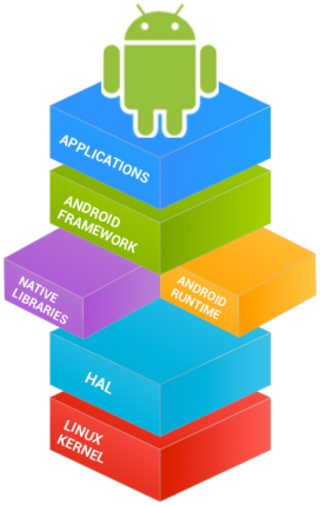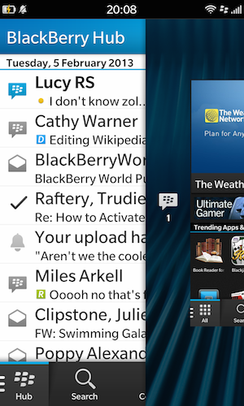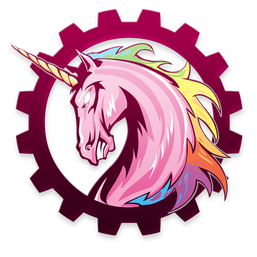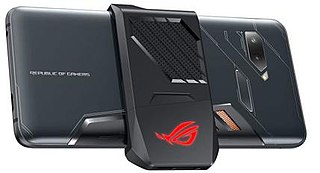Motorola Mobility LLC, marketed as Motorola, is an American consumer electronics manufacturer primarily producing smartphones and other mobile devices running Android. It is a subsidiary of the Chinese multinational technology company Lenovo.

Adobe AIR is a cross-platform runtime system currently developed by Harman International, in collaboration with Adobe Inc., for building desktop applications and mobile applications, programmed using Adobe Animate, ActionScript, and optionally Apache Flex. It was originally released in 2008. The runtime supports installable applications on Windows, macOS, and mobile operating systems, including Android, iOS, and BlackBerry Tablet OS.
A mobile operating system is an operating system for smartphones, tablets, smartwatches, smartglasses, or other non-laptop personal mobile computing devices. While computers such as typical laptops are "mobile", the operating systems used on them are generally not considered mobile ones, as they were originally designed for desktop computers that historically did not have or need specific mobile features. This line distinguishing mobile and other forms has become blurred in recent years, due to the fact that newer devices have become smaller and more mobile unlike hardware of the past. Key notabilities blurring this line are the introduction of tablet computers and light-weight laptops and the hybridization of the two in 2-in-1 PCs.

HTC Sense is a software suite developed by HTC, used primarily on the company's Android-based devices. Serving as a successor to HTC's TouchFLO 3D software for Windows Mobile, Sense modifies many aspects of the Android user experience, incorporating additional features, additional widgets, re-designed applications, and additional HTC-developed applications. The first device with Sense, the HTC Hero, was released in 2009. The HD2 running Windows Mobile 6.5, released later the same year, included Sense. Following the release of the Hero, all future Android devices by HTC were shipped with Sense, except for the Nexus One, the Desire Z, the HTC First, the Google Pixel and Pixel 2, and the Nexus 9 which used a stock version of Android. Also some HTC smartphones that are using MediaTek processors come without HTC Sense.

The Sony Ericsson Xperia X10 is a 2010 high end smartphone in the Xperia series designed by Sony Ericsson. It was the first Sony Ericsson smartphone to run the Android operating system. The phone was shipped with Android 1.6 (Donut), but an upgrade to 2.1 (Eclair) was made available starting 31 October 2010, with a gradual international rollout. Originally, Sony Ericsson stated that the X10 would not receive an upgrade to Android 2.2 (Froyo) or beyond, but the phone was later upgraded to 2.3.3 (Gingerbread) with the updates starting on 29 July 2011.

The Motorola Backflip is a touchscreen smartphone released to the U.S. for AT&T on March 7, 2010, and for other countries on Telus and Optus. It runs the open source Google Android software.

The Nook Color is a tablet computer/e-reader that was marketed by Barnes & Noble. A 7-inch (18 cm) tablet with multitouch touchscreen input, it is the first device in the Nook line to feature a full-color screen. The device is designed for viewing of books, newspapers, magazines, and children's picture books. A limited number of the children's books available for the Nook Color include interactive animations and the option to have a professional voice actor read the story. It was announced on 26 October 2010 and shipped on 16 November 2010. Nook Color became available at the introductory price of US$249. In December 2011, with the release of the Nook Tablet, it lowered to US$169. On 12 August 2012, the price lowered to US$149. On 4 November 2012, the price was further lowered to US$139. The tablet ran on Android.

Android software development is the process by which applications are created for devices running the Android operating system. Google states that "Android apps can be written using Kotlin, Java, and C++ languages" using the Android software development kit (SDK), while using other languages is also possible. All non-Java virtual machine (JVM) languages, such as Go, JavaScript, C, C++ or assembly, need the help of JVM language code, that may be supplied by tools, likely with restricted API support. Some programming languages and tools allow cross-platform app support. Third party tools, development environments, and language support have also continued to evolve and expand since the initial SDK was released in 2008. The official Android app distribution mechanism to end users is Google Play; it also allows staged gradual app release, as well as distribution of pre-release app versions to testers.

BlackBerry 10 (BB10) is a discontinued proprietary mobile operating system for the BlackBerry line of smartphones, both developed by BlackBerry Limited. Released in January 2013, BlackBerry 10 is a complete rework from the company's previous BlackBerry OS software.
Dragontrail, manufactured by AGC Inc., is an alkali-aluminosilicate sheet glass engineered for a combination of thinness, lightness and damage-resistance, similar to Corning's proprietary Gorilla Glass. The material's primary properties are its strength, allowing thin glass without fragility; its high scratch resistance; and its hardness – with a Vickers hardness test rating of 595 to 673.

The LG Optimus 4X HD is a slate, multi-touch smartphone running the Android operating system. Designed and manufactured by LG Electronics. The Optimus 4X HD was the world's first smartphone announced with a quad-core processor along with the HTC One X and the Samsung Galaxy S3 and the fourth phone in the LG Optimus-Android series. LG first introduced the LG Optimus 4X HD at Mobile World Congress. The Optimus 4X HD was launched with Android 4.0 Ice Cream Sandwich. Since April 2013, some variants have had a Jellybean update available.

The Intel AZ210, also marketed as XOLO X900 in India, Orange San Diego in the United Kingdom and Megafon Mint in Russia, is a phone manufactured by Taiwanese OEM Gigabyte for Intel.

Sailfish OS is a Linux-based operating system based on free software, and open source projects such as Mer as well as including a closed source UI. The project is being developed by the Finnish company Jolla.

Moto X is an Android smartphone developed and manufactured by Motorola Mobility, and released in August 2013.

AOKP, short for Android Open Kang Project, is an open-source replacement distribution for smartphones and tablet computers based on the Android mobile operating system. The name is a play on the word kang and AOSP. The name was a joke, but it stuck. It was started as free and open-source software by Roman Birg based on the official releases of Android Open Source Project by Google, with added original and third-party code, features, and control.

Xolo, stylised as XOLO, is an Indian mobile handset brand by Lava International. It manufactures personal electronics devices such as smartphones, tablets and laptops, and accessories such as powerbanks.
Paranoid Android is an open-source operating system for smartphones and tablet computers, based on the Android mobile platform. The latest official version is Topaz, based on Android 13, released on 15 October 2022.
Samsung Galaxy Star 2 Plus G350E is a smartphone manufactured by Samsung Electronics that runs on the open source Android operating system. Announced by Samsung in early August 2014. It has additional software features, expanded hardware, and a redesigned physique from its predecessor, the Samsung Galaxy Star 2.

Android Oreo is the eighth major release and the 15th version of the Android mobile operating system. It was first released as an alpha quality developer preview in March 2017 and released to the public on August 21, 2017.

The ROG Phone is an Android gaming smartphone made by Asus and the first generation of the ROG smartphone series. It was announced on June 8, 2018 at the Computex computer expo, being the first Asus smartphone to be targeted mainly to gamers. It competes with the Razer Phone, Xiaomi Black Shark, and ZTE Nubia Red Magic.















